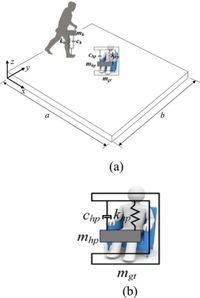A recent study published on March 22, 2025, offers critical insights into how various human body parameters affect the vertical dynamic characteristics of engineered structures, particularly focusing on lightweight CFS composite floors. This research underscores the significance of understanding human-induced vibration, especially in environments where comfort and safety are paramount.
The study highlights that the interaction between pedestrians and the structural characteristics of floors can lead to varying levels of discomfort, particularly in lightweight materials, which are becoming increasingly popular in modern building designs. By establishing a pedestrian-structure-perception coupling equation, the study attempts to fill gaps left by previous research that failed to fully account for the individual dynamics of different users.
The researchers selected 60 individuals, comprising diverse age groups and genders, to serve as test subjects for evaluating the dynamic responses of a specific lightweight floor structure. Key parameters analyzed included the mass, stiffness, and damping ratio of the individuals, all of which significantly influence how vibrations are perceived in real-time.
Notably, results indicated that when individuals walked near the mid-span of the floor, the structural frequency reached its minimum while the damping ratio peaked, which could have significant implications for design engineers. The authors state that "when the pedestrian walks near the mid span of the structure, the frequency of the structure reaches the minimum and the damping ratio of the structure reaches the maximum." This revelation is vital for ensuring that modern lightweight floors remain within acceptable discomfort thresholds.
Further calculations revealed that men’s dynamic parameters have a more profound effect on the floor's frequency and damping characteristics compared to women and children, with the respective values recorded as 3.74% for frequency and an astounding 186.50% for damping ratio changes. As the authors emphasized, "the influence of men’s dynamic parameters on the frequency and damping of the structure is greater than women and children." This finding indicates that design considerations should be gender-sensitive, factoring in these differences when evaluating a structure's suitability for various users.
The overall results demonstrated that as individuals, particularly children, seated in the middle of the floor span resulted in larger mean peak values for one-second root mean square (RMS) acceleration response compared to their adult counterparts. The observed values of 0.2117 m/s² for children, 0.1880 m/s² for women, and 0.1773 m/s² for men highlight the variability in perception of vibrations based on age and gender.
These findings suggest that in practical engineering applications, the dynamic response of the perceiver in coupled systems requires careful consideration; it is essential that engineers prioritize user comfort by analyzing these responses to prevent exceedance of acceptable comfort levels. The study stresses that "when evaluating the serviceability of the floor, the interaction of the pedestrian-structure-perception coupling system should be considered," reinforcing the importance of a multidisciplinary approach in architectural design.
The lightweight floor analyzed in the study measured 8.40 meters in span and 7.20 meters in width, with a plate thickness of 0.1657 meters and a total mass of 5545.20 kilograms. These specifications provide a framework for future studies aiming to assess similar composite materials and structures.
The authors concluded that their findings not only contribute to the existing body of knowledge on pedestrian-induced vibrations but also serve as a guideline for designing public spaces, especially offices and pedestrian bridges, in a way that fosters safety and comfort. By statistically analyzing the peak accelerations experienced by different perceiver types, designers can develop a more comprehensive comfort index that aligns with user needs.
This research opens the door for further investigations that could validate results through experimental data support, enabling enhancements to comfort evaluation systems in various structural designs. As engineering practices evolve to embrace innovative materials, understanding fundamental dynamics related to human interactions becomes irrefutably essential for future advancements in structural safety and comfort regulations.




